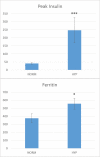Possible dysmetabolic hyperferritinemia in hyperinsulinemic horses
- PMID: 32042647
- PMCID: PMC6971364
- DOI: 10.4314/ovj.v9i4.2
Possible dysmetabolic hyperferritinemia in hyperinsulinemic horses
Abstract
Background: Hyperinsulinemia associated with equine metabolic syndrome and pituitary pars intermedia dysfunction is a risk factor for laminitis. Research in other species has shown elevated body iron levels as both a predictor and consequence of insulin resistance. In humans, this is known as dysmetabolic hyperferritinemia.
Aim: To explore the relationship between equine hyperinsulinemia and body iron levels.
Methods: We reviewed case histories and laboratory results from an open access database maintained by the Equine Cushing's and Insulin Resistance Group Inc. (ECIR). We identified 33 horses with confirmed hyperinsulinemia and laboratory results for serum iron, total iron binding capacity, and ferritin. Pearson correlation was used to test the relationship between insulin and iron indices. Additionally, we performed a secondary analysis of a previously reported controlled trial that was originally designed to test the correlation between iron status and the insulin response in horses. Here, we used a t-test to compare the mean values of insulin and ferritin between horses we categorized as normal or hyperinsulinemic based on their response to an oral challenge.
Results: Serum ferritin exceeded published reference range in 100% of the horses identified from the ECIR database. There were no statistically significant associations between insulin indices (RISQI, log insulin) and iron indices (log serum iron, log TSI%, log ferritin). There were trends for a negative association between RISQI and log iron [r(31) = -0.33, p = 0.058] and a positive association between age and ferritin [r(30) = 0.34, p = 0.054]. From the secondary data analysis of published data, we found significantly elevated ferritin (p = 0.05) in horses considered hyperinsulinemic by dynamic insulin testing compared to horses with a normal response.
Conclusion: These results suggest the potential for iron overload in hyperinsulinemic horses, a feature documented in other species and should stimulate further study into the relationship between insulin and iron dysregulation in the horse.
Keywords: Equine; Ferritin; Hyperinsulinemia; Iron overload.
Figures
Similar articles
-
Effect of Age, Season, Body Condition, and Endocrine Status on Serum Free Cortisol Fraction and Insulin Concentration in Horses.J Vet Intern Med. 2016 Mar-Apr;30(2):653-63. doi: 10.1111/jvim.13839. Epub 2016 Feb 9. J Vet Intern Med. 2016. PMID: 26860336 Free PMC article.
-
Use of the SGLT2 inhibitor canagliflozin for control of refractory equine hyperinsulinemia and laminitis.Open Vet J. 2022 Jul-Aug;12(4):511-518. doi: 10.5455/OVJ.2022.v12.i4.14. Epub 2022 Aug 7. Open Vet J. 2022. PMID: 36118716 Free PMC article.
-
Dysmetabolic hyperferritinemia is associated with normal transferrin saturation, mild hepatic iron overload, and elevated hepcidin.Ann Hematol. 2011 Feb;90(2):139-43. doi: 10.1007/s00277-010-1050-x. Epub 2010 Aug 19. Ann Hematol. 2011. PMID: 20721554
-
Hyperinsulinemic laminitis.Vet Clin North Am Equine Pract. 2010 Aug;26(2):257-64. doi: 10.1016/j.cveq.2010.04.003. Epub 2010 Jun 8. Vet Clin North Am Equine Pract. 2010. PMID: 20699173 Review.
-
Insulin dysregulation.Equine Vet J. 2014 Jan;46(1):103-12. doi: 10.1111/evj.12169. Epub 2013 Nov 18. Equine Vet J. 2014. PMID: 24033478 Review.
Cited by
-
Hematological indexes and iron status in pregnant mares.Arch Anim Breed. 2023 Jul 27;66(3):197-205. doi: 10.5194/aab-66-197-2023. eCollection 2023. Arch Anim Breed. 2023. PMID: 37560356 Free PMC article.
-
Exploring Serum Ferritin's Connection to the Acute Phase Response in Zoo-Managed African Rhinoceroses.Zoo Biol. 2025 Jan-Feb;44(1):16-23. doi: 10.1002/zoo.21873. Epub 2024 Oct 30. Zoo Biol. 2025. PMID: 39478097 Free PMC article.
-
Safety and efficacy of a novel iron chelator (HBED; (N,N'-Di(2-hydroxybenzyl)ethylenediamine-N,N'-diacetic acid)) in equine (Equus caballus) as a model for black rhinoceros (Diceros bicornis).J Anim Physiol Anim Nutr (Berl). 2022 Sep;106(5):1107-1117. doi: 10.1111/jpn.13745. Epub 2022 Jul 27. J Anim Physiol Anim Nutr (Berl). 2022. PMID: 35894091 Free PMC article.
-
Rhinoceromics: a multi-amplicon study with clinical markers to transferrin saturation levels in ex-situ black rhinoceros (Diceros bicornis michaeli).Front Microbiol. 2025 May 29;16:1515939. doi: 10.3389/fmicb.2025.1515939. eCollection 2025. Front Microbiol. 2025. PMID: 40510676 Free PMC article.
References
-
- Asplin K.E, Sillence M.N, Pollitt C.C, McGowan C.M. Induction of laminitis by prolonged hyperinsulinaemia in clinically normal ponies. Vet. J. 2007;174:530–535. - PubMed
-
- Clauss M, Paglia D.E. Iron storage disorders in captive wild mammals: the comparative evidence. J. Zoo Wildl. Med. 2012;43:S6–18. - PubMed
-
- Fargion S, Dongiovanni P, Guzzo A, Colombo S, Valenti L, Fracanzani A.L. Equine laminitis: Induced by 48h hyperinsulinaemia in Standardbred horses. EVJ Equine Vet. J. 2005;42:129–135. Iron and insulinA., McGowan, C.M., Sillence, M.N. and Pollitt, C.C. 2010. - PubMed
-
- de Laat M.A, Sillence M.N. The repeatability of an oral glucose test in ponies. Equine Vet. J. 2017;49:238–243. - PubMed
MeSH terms
Substances
LinkOut - more resources
Full Text Sources
Miscellaneous

